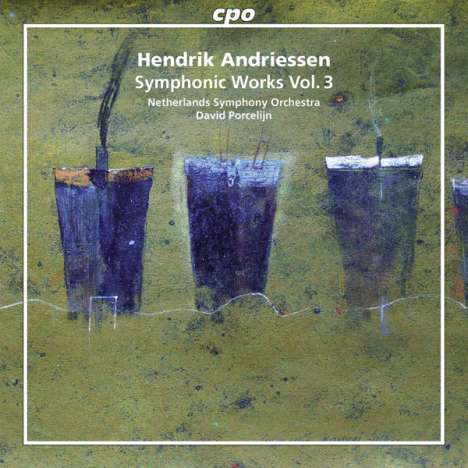Hendrik Andriessen: Orchesterwerke Vol.3 auf CD
Orchesterwerke Vol.3
Herkömmliche CD, die mit allen CD-Playern und Computerlaufwerken, aber auch mit den meisten SACD- oder Multiplayern abspielbar ist.
Lassen Sie sich über unseren eCourier benachrichtigen, falls das Produkt bestellt werden kann.
Symphonie Nr. 3; Symphonie concertante; Chantecler-Ouvertüre
- Künstler:
- Netherlands Symphony Orchestra, David Porcelijn
- Label:
- CPO
- Aufnahmejahr ca.:
- 2012
- UPC/EAN:
- 0761203772322
- Erscheinungstermin:
- 28.4.2015
Ähnliche Artikel
Packende Symphonik Vol. 3
Auch in seiner dritten Symphonie zeigt Hendrik Andriessen das ganze Arsenal seiner Kunst, vor allem im Finale, das aus einer brillanten Fuge besteht: Nichts in dieser Fuge klingt schwer oder nach intellektueller Komplexität. Vielmehr ist sie von demselben starken, energischen Drängen erfüllt, das der Komponist in jenen aufregenden Nachkriegsjahren empfunden haben dürfte. Das Concertgebouw Orkest brachte die dritte Symphonie am 26. Oktober 1946 unter der Leitung des Komponisten zur Uraufführung. Die Ecksätze seiner Symphonie concertante erinnern eher an wohlgeformte symphonische Sätze, indessen das zentrale Andante grazioso mit seinen Variationen dem Modell des 18. Jahrhunderts nähersteht. Dieser Satz verdient das Attribut »konzertant« in ganz besonderer Weise: Die Holz- und Blechbläser haben prominente Partien, während die Solovioline und die Harfe in der wunderschönen Aria auftreten. Ergänzt wird die CD mit Andriessens Ouvertüre Chantecler, die von dem gleichnamigen Schauspiel des französischen Bühnendichters Edmond Rostand (1868–1918) inspiriert worden ist, aber der Komponist wies in seinem Vorwort darauf hin, dass das Publikum die Musik nicht rein programmatisch verstehen sollte. "Ein weiteres Programm mit seiner kraftvoll pulsierenden Musik, die David Porcelijn brillant wiedergibt." (Pizzicato zu Vol. 2)
Product Information
Gripping Symphonic Music Vol. 3
In his third symphony Hendrik Andriessen again displays the whole arsenal of his artistry, above all in the finale consisting of a brilliant fugue. Nothing in this fugue sounds heavy or like intellectual complexity; it instead is filled with the same strong, energetic aspirations that the composer must have felt during the exciting postwar years. The composer conducted the premiere of his third symphony by the Concertgebouw Orchestra on 26 October 1946. The framing movements of his Symphonie concertante are more reminiscent of finely formed symphonic movements, while the central Andante grazioso with its variations is closer to the model from the eighteenth century. This movement merits the attribute »concertante« in a very special way: the woodwinds and brass instruments have prominent parts, while the solo violin and the harp appear in the wonderfully beautiful aria. Andriessen’s Chantecler, an overture inspired by the drama of the same name by the French stage poet Edmond Rostand (1868-1918), rounds off the CD program. However, in his introduction the composer indicated that the public was not to understand the music in a purely programmatic manner. »Another program with his powerfully pulsating music, brilliantly rendered by David Porcelijn« (Pizzicato of Vol. 2).
Disk 1 von 1 (CD)
Sinfonie Nr. 3 (1946)
-
1 1. Ouvertüre
-
2 2. Sonata
-
3 3. Sarabande
-
4 4. Fuga
Sinfonie Conertante
-
5 1. Andante - Allegro
-
6 2. Tema con variazione
-
7 3. Andante - Allegro energico
-
8 Ouvertüre "Chantecler"
Mehr von Hendrik Andriessen
-
Hendrik AndriessenSämtliche symphonische Werke4 CDsAktueller Preis: EUR 24,99
-
Hendrik AndriessenOrchesterwerke & Konzerte "Miroir de Peine"2 CDsAktueller Preis: EUR 17,99
-
Hendrik AndriessenMiroir de Peine für Sopran & OrgelCDVorheriger Preis EUR 14,99, reduziert um 0%Aktueller Preis: EUR 8,99
-
Irene Greulich - Eine Abendmusik in der Wenzelskirche zu NaumburgCDAktueller Preis: EUR 19,99















